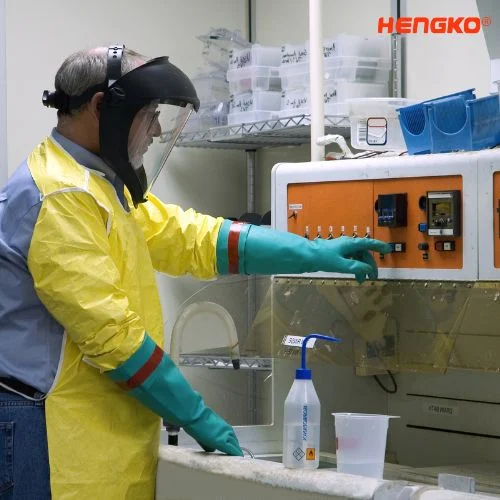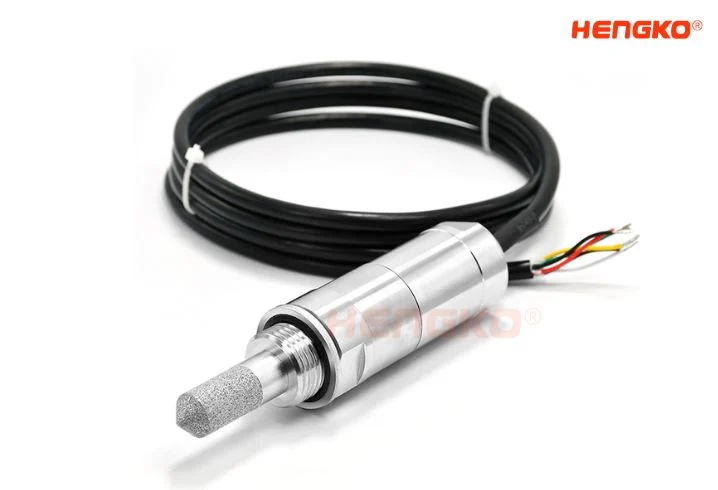Cleanroom Temperature & Humidity Monitoring
Ensuring Optimal Conditions for Precision and Compliance of Ceanroom
Startseite " Cleanroom Temperature and Humidity Monitoring
Wide Humidity Transmitter to Solve Your Cleanroom Humidity Monitoring Problems
Comprehensive Solutions for Effective Cleanroom Humidity Control
To Solve Your Cleanroom Humidity Monitoring Problems by HENGKO’s Wide Humidity Transmitter Option
Maintaining optimal humidity levels in cleanrooms is crucial for ensuring product quality, safety, and compliance with industry standards. HENGKO offers a comprehensive solution to your cleanroom humidity monitoring needs with our wide range of humidity transmitters.
Benefits of Using HENGKO’s Humidity Transmitters:
- Enhanced Product Quality: By maintaining precise humidity levels, our transmitters help prevent contamination and ensure the integrity of sensitive products.
- Improved Compliance: Our transmitters aid in meeting stringent regulatory requirements, providing peace of mind and reducing the risk of non-compliance.
- Cost Efficiency: With reliable performance and low maintenance needs, HENGKO’s humidity transmitters offer a cost-effective solution for cleanroom humidity monitoring.
HENGKO’s wide humidity transmitter options are the ideal choice for tackling cleanroom humidity monitoring challenges. Trust HENGKO to deliver the accuracy, reliability, and performance you need to maintain the highest standards in your cleanroom environment.
Several Probe Humidity Sensor Option - HG808 to Montoring Temp and Humidity. Dew Ponit for Cleanroom.
Key features
*The HG808 Air Duct Series Transmitter is equipped with a sensitive waterproof and anti fine dust high-temperature probe, with a temperature range of -60~60 ℃.
*Mit der Standard-Industrieschnittstelle RS485 mit digitalem Signalausgang oder 4-20 mA Analogausgang, mit Anzeigefunktion, kann es an Digitalanzeigen vor Ort, PLCs, Frequenzumrichter, industrielle Steuerrechner und andere Geräte angeschlossen werden.
Taupunkt + Modbus RS485 Beide Ausgänge
▪ Integriertes Design, einfach und elegant
Industrietauglicher ESD-Schutz und verpolungssicheres Design der Stromversorgung
▪ Verwendung von wasser- und staubdichten sowie hochtemperaturbeständigen Sonden
Empfindlicher wasserdichter und feinstaubgeschützter Hochtemperaturfühler
▪Standard RS485 Modbus RTU Kommunikationsprotokoll
Hohe Präzision, hohe Stabilität, LP66 wasserdicht und staubdicht
Verschiedene Sondenmaterialien verfügbar
Duct Humidity Temperature Sensor
HENGKO bietet eine breite Palette von Temperatur- und Feuchtesensoren für jeden Bedarf, von Temperatur- und Feuchtesensoren aus Edelstahl bis hin zu Taupunkttransmittern. Unsere Sensoren sind genau, zuverlässig und langlebig und damit ideal für eine Vielzahl von Anwendungen
4.1 Taupunkt RS485 - Integrierte Kanalsonde Serie
HENGKO bietet eine breite Palette von Temperatur- und Feuchtesensoren für jeden Bedarf, von Temperatur- und Feuchtesensoren aus Edelstahl bis hin zu Taupunkttransmittern. Unsere Sensoren sind genau, zuverlässig und langlebig und damit ideal für eine Vielzahl von Anwendungen
What Process of Cleanroom need to Monitor Temperature and Humidity ?
All cleanrooms need to monitor temperature and humidity. This is because temperature and humidity can affect:
- Yield: Improper temperature and humidity levels can damage products being manufactured in the cleanroom.
- Quality: Incorrect temperature and humidity can cause inconsistencies in the manufacturing process, leading to lower quality products.
- Komfort: Extreme temperatures and humidity levels can make it uncomfortable for workers, which can lead to errors.
Here are some additional points to consider:
- Standards: ISO 14644 sets forth guidelines for cleanroom classifications. These classifications include recommended temperature and humidity ranges.
- Specific processes: Some processes within a cleanroom may have even more specific requirements for temperature and humidity.

5-Factors You Should Care When Choose Humidity Transmitter for Your Cleanroom Monitoring ?
Here are 5 factors you should consider when choosing a humidity transmitter for your cleanroom monitoring:
Genauigkeit: This is the most important factor to consider. You need a transmitter that can measure humidity levels accurately over the entire range that will be used in your cleanroom.
Reaktionszeit: This is the amount of time it takes for the transmitter to respond to changes in humidity levels. You need a transmitter with a fast response time so that you can take corrective action quickly if necessary.
Langfristige Stabilität: Over time, all transmitters can drift and become less accurate. You need a transmitter that is stable and will not require frequent calibration.
Kalibrierung: Speaking of calibration, you need to consider how often the transmitter will need to be calibrated and how easy it is to calibrate.
Kosten: The cost of the transmitter is obviously a factor to consider. However, you should not sacrifice accuracy, response time, or stability for a lower price.
FAQ
Why is temperature and humidity monitoring critical in cleanrooms?
Maintaining consistent and precise temperature and humidity levels is essential in cleanrooms for several reasons:
Product Yield and Quality: Improper temperature and humidity can negatively impact the manufacturing process of sensitive materials and products commonly found in cleanrooms. Delicate components used in electronics or pharmaceuticals can be damaged by fluctuations in temperature or excessive moisture. Inconsistent humidity can also lead to static discharge, which can damage sensitive electronic components.
Process Control: Many cleanroom processes are highly sensitive to temperature and humidity variations. For example, in microchip fabrication, even slight temperature changes can cause dimensional variations in the circuits. Precise humidity control is also crucial for processes like photolithography, which uses light-sensitive materials.
Worker Comfort and Safety: Extreme temperatures and humidity levels can create an uncomfortable work environment for cleanroom personnel. Discomfort can lead to fatigue, reduced concentration, and an increased risk of errors. Additionally, high humidity can promote the growth of mold and mildew, which can pose health risks.
What standards or guidelines exist for temperature and humidity in cleanrooms?
ISO 14644 is the international standard that outlines the classification of cleanrooms based on airborne particle concentration. This standard provides recommended ranges for temperature and humidity for different cleanroom classifications. However, it’s important to remember that these are recommendations, and specific processes within a cleanroom may have even tighter requirements. Consulting the technical specifications for the products or processes being conducted in the cleanroom is vital to determine the most appropriate temperature and humidity levels.
What are the key factors to consider when choosing a temperature and humidity monitoring system for a cleanroom?
Several factors come into play when selecting a monitoring system for your cleanroom:
Genauigkeit: This is paramount. Your system needs to deliver highly accurate measurements of both temperature and humidity across the entire range required for your specific cleanroom environment.
Reaktionszeit: A fast response time ensures timely detection of any fluctuations in temperature or humidity. This allows for quick corrective actions to be taken before they can impact product yield or quality.
Data Logging and Alerting: The ability to continuously log data and generate alerts when pre-defined thresholds are breached is crucial. This data can be used for trend analysis, ensuring consistent environmental conditions and identifying potential issues before they escalate.
Sensor Suitability: Select sensors specifically designed for cleanroom environments. These sensors should be constructed from materials that are compatible with cleanroom cleaning protocols and not prone to particle shedding.
Wireless vs. Wired Systems: Wireless systems offer greater flexibility in terms of placement, but wired systems may provide a more reliable connection and be less susceptible to interference. Consider your cleanroom layout and prioritize data security needs when making this choice.
Skalierbarkeit: If you anticipate expanding your cleanroom operations in the future, choose a monitoring system that can be easily scaled to accommodate additional sensors and data points.
What are some best practices for cleanroom temperature and humidity monitoring?
Strategic Sensor Placement: Place sensors in critical locations throughout the cleanroom, considering potential sources of temperature or humidity variations like air handling units, doorways, and equipment.
Calibration and Maintenance: Regularly calibrate your sensors according to the manufacturer’s recommendations to ensure accuracy. Develop a preventative maintenance plan for your monitoring system to maintain optimal performance.
Data Analysis and Review: Routinely analyze the data collected by your monitoring system. Look for trends, identify potential issues, and take corrective actions when necessary. Data analysis can also help you optimize your cleanroom environment for improved process control and product quality.
Documentation and Record Keeping: Maintain detailed records of calibration certificates, maintenance logs, and sensor data. This documentation is essential for regulatory compliance and helps demonstrate your commitment to maintaining a controlled environment.
Verwandte Produkte
FIND RIGHT TEMPERATURE & HUMIDITY TRANSMITTER
Teilen Sie uns Ihr Projekt noch heute mit
Nennen Sie uns Details zu Ihrem Monitor-Projekt,
Wir bieten Ihnen die beste Lösung zu wettbewerbsfähigen Preisen innerhalb von 3 Tagen.
Wir bieten Ihnen die beste Lösung zu wettbewerbsfähigen Preisen innerhalb von 3 Tagen.

Die Welt verbreiten
HENGKO ist ein weltweit führender Anbieter von industriellen Sensorlösungen, der für sein einzigartiges Design und seine hervorragende Leistung bekannt ist. Unsere Temperatur- und Feuchtigkeitstransmitter und -sensoren werden in einer Vielzahl von Branchen eingesetzt, darunter die Lebensmittel- und Getränkeindustrie, die pharmazeutische Industrie, die Fertigung und die Umweltüberwachung.
0
+
Jahre der Erfahrung
0
Weltweite Verkäufe
0
K
Industrielle Projekte
Andere beliebte Projekte
Weinkeller
Perfekte Konservierung: Temperatur- und Feuchtigkeitsmanagement für die Weinalterung
Krankenhäuser und Laboratorien
Präzision im Gesundheitswesen: Sicherstellung steriler und stabiler Umgebungen
Landwirtschaftliche Lagerhäuser
Optimierung der Lagerung von Kulturpflanzen: Stabilisierung der Bedingungen nach der Ernte







